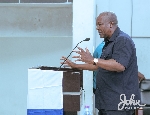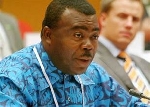COP 15: A story of hope emerges around Africa’s ‘audacious’ Great Green Wall
 UNEP's Susan Gardner (in the foreground, left) chats to African Development Bank VP Kevin Kariuki on 13 May 2022 at the COP 15 conference in Abidjan
UNEP's Susan Gardner (in the foreground, left) chats to African Development Bank VP Kevin Kariuki on 13 May 2022 at the COP 15 conference in Abidjan
The COP15 conference of the United Nations Convention to Combat Desertification hosted discussions on the Great Green Wall, an ambitious project to restore a vast stretch of African desert into a flourishing green belt that supports surrounding communities.
One session, held Friday 13 May in Abidjan, Côte d’Ivoire, was on investment opportunities around the Great Green Wall. It featured development partners collaborating on the initiative, including the UN Convention to Combat Desertification, the African Development Bank, the Global Environment Facility, the UN Environment Program, the Pan-African Agency of the Great Green Wall and representatives from the countries that are hosting the mammoth undertaking: Burkina Faso, Chad, Mali, Niger and Senegal.
“The importance of coordination within countries is something we are all working on, working across sectoral ministers, because the Great Green Wall is not a tree-planting initiative but a mosaic which can help in development, which can really improve life for the communities…which also can really change the way we see the Sahel, as a land of opportunities,” said Birguy Lamizana, speaking on behalf of the Executive Secretary of the UN Convention to Combat Desertification.
Kevin Kariuki, Vice President for Power, Energy, Climate and Green Growth at the African Development Bank, said his institution was well on its way to its target of contributing $6.5 billion to this project. He said the Bank had mobilized more than $ 1 billion – and about $2 billion through transformative programs like Desert to Power, a flagship solar energy project in the Sahel.
Susan Gardner, Director of Ecosystems at the UN Environment Program, said the Great Green Initiative had attracted $14 billion from the government of France, the World Bank and the African Development Bank. “Certainly what we’re hearing is that the Great Green Wall is much more than growing trees, and in the Sahel, it’s a story that we can think of as a story of hope. It’s a story about how intact ecosystems like forests are nature’s shield that can help us, as a shield against the compounding consequences of the global crisis of climate change,” she said.
Country representatives noted the progress they had made in achieving Great Green Wall goals but said this was just the beginning. “By 2030, we aim to restore nine million hectares of forests, develop 5,000 hectares of fodder crops, and strengthen the use of solar energy for 45,000 households. We have on hand about 15 projects that have not yet had funding and we are counting on this COP 15 to establish strong partnerships in this direction,” said Diallo Toumany, Director General of the Great Green Wall Agency Mali.
A second session on 13 May brought together researchers, experts, NGOs, and other actors in the field, to discuss knowledge-based alliances to ensure the success of the Great Green Wall project by 2030. Speakers highlighted the reorientation of the project, initially based on afforestation and now having to integrate a wide range of components, including security and the resilience of populations, energy, water, policy integration, and land encroachment by cash crops.
But the main challenge is related to the size of the project: How to connect and engage the different stakeholders, build robust alliances and ensure proper monitoring and evaluation within the required deadlines.
The speakers proposed breaking down barriers and moving toward hybrid approaches (managerial, participatory, systemic, etc.) as well as bringing all actors together (researchers, decision-makers, public officials) to produce new knowledge in a more coherent manner.
NGO stakeholders called for research to be timely, accessible and in line with the needs of communities. Progress has been made with the establishment of a Task Force for monitoring and evaluation, the harmonization of 40 indicators and the establishment of National Coalitions of the Great Green Wall.
“The Great Green Wall is Africa’s most audacious nature-based solution with enormous potential for wealth and abundance that can improve lives and livelihoods across communities at scale, thus reversing the catastrophic convergence of climate and land degradation. It needs real collaborative action to be on the front burner of actors at all levels,” said Tabi Joda, coordinator of One Billion Trees for Africa and an ambassador for the Great Green Wall project.
The Great Green Wall is an integrated landscape approach that allows countries to restore degraded land and promote sustainable development along an 8,000-km corridor across the Sahara and the Sahel. The overarching goal is to create10 million jobs, sequester 250 million tons of carbon and restore 100 million hectares of degraded land in 11 countries.
The COP 15 conference began on 9 May in Abidjan and ends on 20 May.
Source: afdb
Trending News

NPP PWDs affirm support for Bawumia
08:54
Gov’t releases ₵26m to institutional suppliers
11:52
PAC orders East Gonja Municipal Assembly to pay contractor GHS92,704 with interest
06:09
Parliament reconvenes late May, denies Bagbin delaying recall over NDC ties
08:37
Feeding grants'll be paid directly to school heads in my next gov’t – Mahama promises
11:02
Lack of public purse protection ‘pathetic’ – Sam Jonah calls out ‘weaponisation of state agencies against opponents, assault on press freedom'
04:02
Gov't plans to revise traditional customs following controversial Gborbu marriage
08:30
NDC Youth Wing expresses solidarity with nurses and midwives
10:08
Let's do away with 'slash and burn' politics- Adutwum
03:26
Labour threatens strike over unpaid pensions
08:18



